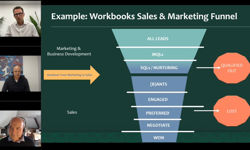The Advertising Association used the occasion as the launch pad for its new report – Advertising Pays 2: How Advertising Can Unlock UK Growth Potential (free to download here), which focused on small and medium sized businesses (SMEs) and the growth opportunity they represent both to UK plc and the advertising community. The summit also included a fascinating presentation from Jamie Isenwater, co-founder of Ash Park Capital, about the opportunity at the other end of the market, the mega brands that are the top consumer staples companies.
The SME Opportunity
99% of all British companies are SMEs (defined as companies with fewer than 250 employees). They represent 40% of turnover, 50% of jobs, but only account for 18% of ad spend. The Advertising Pays 2 report points to the massive growth opportunity that this sector represents, and concludes that if British SMEs could expand their exports to the European average, this would be worth an extra £40bn to the UK economy each year.
And, this being an Advertising Association bash, the best way for SMEs to achieve that growth is by advertising more, because, as last year’s report clearly demonstrated… investment in advertising leads to increased sales. If SMEs increase their advertising spend, then the advertising community (agencies and media owners – us!) benefits directly.
So, what’s stopping them?
A number of things: a wide-spread perception that advertising is a ‘big-company thing’, perceived high costs, short-termism and cash-flow problems which means that advertising is seen as a cost rather than as an investment, lack of know-how and previous bad experience where advertising has been done sporadically and poorly. The Guardian’s Andrew Miller also identified a lag effect with regards to digital expertise, with most small companies simply not knowing where to start when it comes to digital marketing and social media. Big companies are struggling with it too, he said, so it’s hardly surprising that smaller companies are finding it difficult.
The overriding focus, therefore, should be on educating the SME sector about the benefits of advertising, what constitutes best practice and providing them with the know-how to do it properly. A number of speakers alluded to the fact that there were already numerous government initiatives to help SMEs, both in the area of marketing and promotion, but also with access to funding, however research showed that 75% of SMEs were blissfully unaware of the existence of these schemes. At the very least, a more joined-up approach by government, along with better advertising (!) of their offering was urgently needed.
Agencies too had their part to play and it was acknowledged that for many agencies in the room, servicing blue chip brands was their bread and butter work and that they were not set up to cater for the SME market. Most big agencies are more concerned with stealing market share from each other, than growing the sector as a whole. How many agencies have a training tab on their website, one speaker asked rhetorically.
There were exceptions. Matthew Dearden, CEO of Clear Channel, said that they had recently restructured their business, splitting it in two, one to look after the big brands, the other to look after medium sized companies.
Debbie Klein, CEO of Engine, also outlined how she thought more agencies could start to give affordable access to their skills to smaller companies, and that was through a template driven self-service model.
But it seemed to me that rather than trying to get the big agencies to change their ways (someone has to cater for the top end of the market after all), there is a gap in the market here for innovative marketing services companies, to tailor an offering for the SME.
As for publishers, as media-owners, it’s clearly in our interests to boost SME ad spend, and our trade associations (the PPA, NPA, AOP, Newspaper Society) need to continue to engage with advertising bodies (Advertising Association, IAB, IPA) as well as with government to help make the case for advertising and improved access to education and training for SMEs.
The Big Brand Opportunity
When it comes to not spending enough on advertising, smaller companies got most of the attention at Lead 2014, but big brands fall short in this regard too, and the downturn in advertising which has so badly affected publishers, is in large part down to reduced spending by big brands.
How can this be so, when everyone in the room knows that advertising pays? The problem is that not everyone outside the room takes this as a given.
Jamie Isenwater has done a lot of research in this area, focusing on the marketing spend of the top 35 consumer staples companies over the past six years. In particular, he analysed the differing responses by those 35 companies to the 2008 financial crash and the fundamental question of how to react to the downturn. Do you continue to invest in advertising at pre-downturn levels, or do you cut back?
Jamie’s research showed that those companies that maintained their advertising levels enjoyed 30% faster growth than those who didn’t. Put simply, faster sales growth is driven by higher ad spend. Shouldn’t that fact be the end of the story? Surely no other blue chip mega brand will ever make the same mistake again? If only.
The fact that, in 2008, a plausible case could still be made by intelligent people and swallowed by other intelligent people is THE challenge that we as an industry face.
Why isn’t the link between higher ad spend and higher sales accepted as a business truth?
Jamie put this down primarily to ignorance on matters of advertising and promotion within the financial community; in his research, 83% of analysts polled answered ‘yes’ to the question, ‘Are there aspects of A&P you would like to know more about?’
Why are these important people, whose performance impacts so directly on our businesses, so ignorant?
Jamie put it down to three things. Firstly, a lack of consistency with regards terminology in financial reporting. When A&P can be described in one set of accounts as ‘Marketing Spend’, as ‘Media Spend’ in another, and any number of other variations in another, then it makes comparability extremely difficult. Secondly, a lack of transparency due to commercial sensitivity further hampers detailed analysis. Thirdly, poor measurabity, both the lack of industry standard measures and the failure to define performance in financial terms (“if you want to connect with finance people, you must provide numbers”). Measuring the success of your half time Super Bowl commercial in terms of increased page views does nothing for your average money man. Put a financial value on it!
The solution is simple: get everyone around the world to use the same terminology in their financial reporting, be totally transparent with regards to their advertising spend and to use industry standard financial measures of advertising spend.
Easy? No, of course not, and Unilever Chairman Amanda Sourry dismissed calls for greater transparency as a little naïve. Perhaps, but standardised terminology and financial measures of advertising investment must be achievable in the long term. Achieving this and bringing the money men onside would mean much higher ad spend by the global mega brands, and media owners would obviously stand to benefit hugely.
Again, as with the SMEs, the solution would appear to lie with our trade associations working closely with relevant parties, including the accountancy profession, both nationally and internationally.
A lot of hard work and a long term project for sure, but the prize for future publishers is great indeed.












